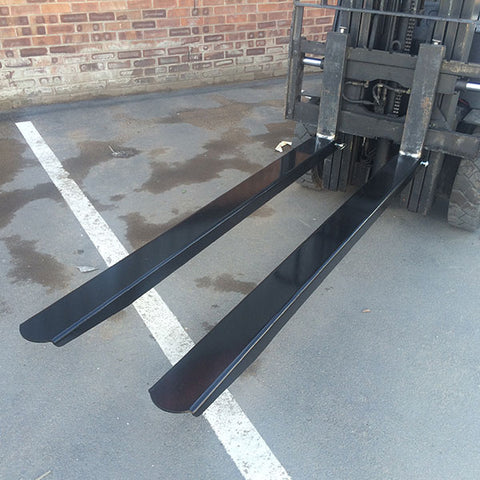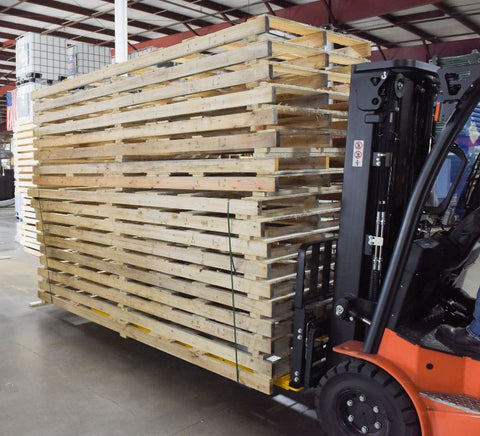The Ultimate Guide to Fork Extensions
Forklifts are an essential tool in material handling, enabling the efficient movement of heavy loads. However, sometimes the standard forks may not be long enough to safely handle larger or longer items. This is where fork extensions come into play. In this ultimate guide, we will explore the various aspects of fork extensions and provide you with all the information you need to know.
Understanding Fork Extensions
What are Fork Extensions?
Fork extensions, also known as fork sleeves, are attachments that are mounted onto the existing forks of a forklift truck to increase their length. They are typically made of durable steel and can be easily attached or removed as needed. Fork extensions come in various lengths, widths, and styles to accommodate different load requirements.
When selecting fork extensions, it is crucial to consider the weight capacity they can support. Exceeding the recommended weight limit can compromise the safety and stability of the forklift operation. Additionally, it is important to ensure that the fork extensions are securely fastened to the forks to prevent any accidents or damage during material handling tasks.

The Role of Fork Extensions in Material Handling
Fork extensions are designed to enhance the versatility and functionality of forklifts, allowing them to handle larger loads with ease. They provide additional length to the forks, enabling forklift operators to safely pick up, transport, and stack items that exceed the standard fork length. This makes them especially useful when dealing with long or awkwardly shaped items such as lumber, pipes, or steel bars.
Moreover, fork extensions can improve efficiency in warehouse operations by reducing the need for manual handling or the use of additional equipment. By extending the reach of the forklift forks, workers can load and unload goods more quickly and with greater precision. This not only increases productivity but also minimises the risk of damage to goods and potential injuries to personnel.
Different Types of Fork Extensions
Round vs. Square Fork Extensions
When it comes to fork extensions, one of the key decisions you need to make is whether to opt for round or square ones. Round fork extensions are ideal for handling cylindrical objects as they provide maximum surface contact, ensuring a secure grip. On the other hand, square fork extensions offer increased stability and are better suited for carrying square or rectangular loads.
Another factor to consider when choosing between round and square fork extensions is the manoeuvrability of the forklift. Round fork extensions allow for easier navigation in tight spaces due to their smooth edges, whereas square fork extensions may provide more resistance when turning corners or manoeuvring in confined areas.
The Importance of Fork Extension Length
The length of the fork extensions you choose is crucial as it determines the maximum load capacity and stability. It is essential to select fork extensions that are long enough to support your loads properly. The general rule of thumb is that the length of the fork extensions should not exceed more than 1.5 times the length of the forklift's original forks. This ensures sufficient load distribution and prevents overloading.
Moreover, the length of the fork extensions can also impact the overall balance of the forklift. Longer extensions may extend the load further away from the forklift, affecting its centre of gravity and potentially making it more prone to tipping. It is important to strike a balance between the length of the extensions and the stability of the forklift to ensure safe and efficient operation.

Selecting the Right Fork Extensions
Factors to Consider when Choosing Fork Extensions
There are several factors to consider when selecting fork extensions for your forklift. Firstly, you need to determine the maximum load weight and size you will be handling. This will help you choose the appropriate length and weight capacity of the fork extensions. Additionally, you should consider the compatibility of the fork extensions with your forklift model and the type of loads you typically handle.
When selecting fork extensions, it is also important to take into account the material of the extensions. Fork extensions are commonly made from steel, which provides durability and strength, ideal for heavy-duty applications. However, if you are handling delicate loads or require non-slip properties, you may opt for fork extensions with a rubber coating to prevent damage and slippage.
How to Measure for Fork Extensions
Measuring for fork extensions is a simple process that requires accuracy. Start by measuring the width of your forklift's existing forks. Then, you should measure the length required to safely handle your loads, ensuring that it does not exceed the recommended guidelines. It's crucial to measure carefully to ensure the fork extensions are the correct size for your needs. Furthermore, when measuring for fork extensions, consider the thickness of the forks. The thickness of the forks will impact the compatibility of the extensions and the stability of the loads. Ensure that the fork extensions selected have a suitable thickness to securely attach to your forklift's existing forks and provide stability when lifting heavy items.

Safety Considerations for Using Fork Extensions
Proper Installation of Fork Extensions
Ensuring the proper installation of fork extensions is essential for safe and efficient operation. Before attaching the extensions, inspect them for any damage, such as cracks or bends, that could compromise their structural integrity. Once confirmed that they are in good condition, carefully slide the fork extensions onto the forklift's forks until they are securely in place. Always make sure they are evenly seated on both forks.
When installing fork extensions, it is crucial to consider the load capacity of both the extensions and the forklift itself. Exceeding the weight limit can lead to instability and potential accidents. Refer to the manufacturer's guidelines to determine the maximum load capacity for your specific fork extensions and forklift model. Additionally, ensure that the extensions are properly secured with safety pins or bolts to prevent any movement during operation.
Regular Maintenance and Inspection
Just like any other piece of equipment, fork extensions require regular maintenance and inspection to ensure they are in optimal condition. Inspect them for any signs of wear or damage before each use, paying attention to welds, edges, and overall structural integrity. It's also important to clean and lubricate the fork extensions regularly to prevent rust and maintain smooth operation.
Furthermore, consider implementing a maintenance schedule to keep track of when inspections and lubrication are due. This proactive approach can help prevent unexpected issues and prolong the lifespan of your fork extensions. Keep detailed records of maintenance activities, including any repairs or replacements, to ensure compliance with safety regulations and standards.
The Impact of Fork Extensions on Load Handling
How Fork Extensions Affect Load Capacity
It's crucial to understand the impact that fork extensions can have on the load capacity of your forklift. While fork extensions provide additional length for handling larger loads, they also affect the load center and stability. The load capacity of the forklift decreases as the distance between the load and the fulcrum point increases. Therefore, it's essential to consider the load capacity rating of both the forklift and the fork extensions.
Moreover, it is important to note that the type of material being handled also plays a significant role in determining the impact of fork extensions on load capacity. For instance, dense and heavy materials may put more strain on the forklift when using extensions compared to lighter loads. Therefore, conducting a thorough assessment of the materials being handled is crucial in ensuring safe and efficient operations.

Balancing Loads with Fork Extensions
When using fork extensions, proper load balancing becomes even more critical. To maintain stability and prevent accidents, it's vital to distribute the load evenly across the fork extensions. Carefully position the load on the forks, ensuring it doesn't extend beyond the overall length of the fork extensions. Remember to keep the load low and near the front axle of the forklift for optimal balance.
Furthermore, considering the height at which the load is being carried is essential in balancing loads with fork extensions. Higher lifting heights can impact the stability of the forklift, especially when using extensions. It is advisable to adhere to recommended lifting heights and load capacities to prevent any potential risks or accidents in the workplace.
Conclusion
In conclusion, fork extensions serve as invaluable attachments that expand the capabilities of forklifts in handling larger or longer loads. By understanding the different types of fork extensions, selecting the right ones for your needs, and prioritising safety, you can effectively utilise fork extensions to improve the efficiency of your material handling operations.

